Leica V-LUX 5 vs Panasonic FZ1000 II
The Leica V-LUX 5 and the Panasonic Lumix DC-FZ1000 II are two digital cameras that were announced, respectively, in July 2019 and February 2019. Both the V-LUX 5 and the FZ1000 II are fixed lens compact cameras that are equipped with an one-inch sensor. Both cameras offer a resolution of 20 megapixels.
Below is an overview of the main specs of the two cameras as a starting point for the comparison.

Check V-LUX 5 price at
amazon.com

Check FZ1000 II price at
amazon.com
Going beyond this snapshot of core features and characteristics, what are the differences between the Leica V-LUX 5 and the Panasonic Lumix DC-FZ1000 II? Which one should you buy? Read on to find out how these two cameras compare with respect to their body size, their imaging sensors, their shooting features, their input-output connections, and their reception by expert reviewers.
Body comparison
The side-by-side display below illustrates the physical size and weight of the Leica V-LUX 5 and the Panasonic FZ1000 II. The two cameras are presented according to their relative size. Three consecutive perspectives from the front, the top, and the back are available. All width, height and depth dimensions are rounded to the nearest millimeter.
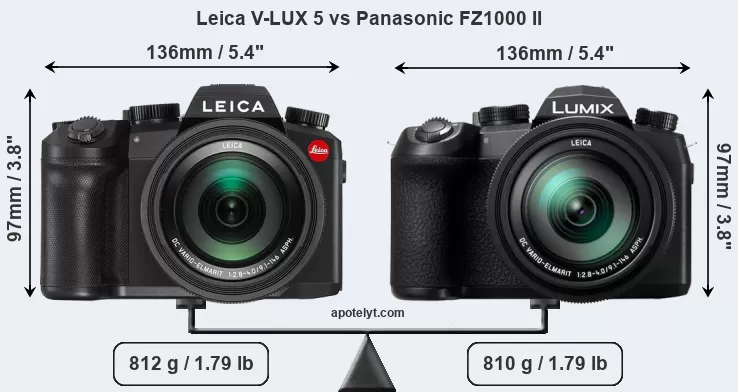
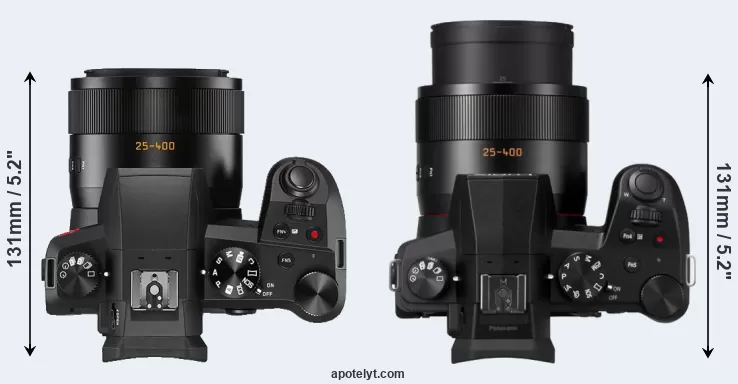
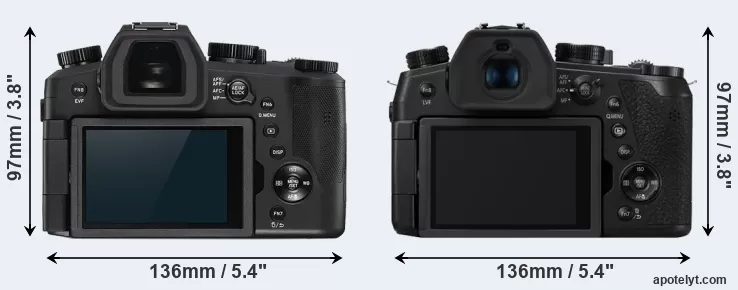
In this particular case, the Leica V-LUX 5 and the Panasonic FZ1000 II have exactly the same width and height, and, thus, have identically-sized bodies. However, the Panasonic is slightly lighter (0 percent) than the Leica. In this context, it is worth noting that neither the V-LUX 5 nor the FZ1000 II are weather-sealed.
The battery packs of both cameras can be charged via USB, which can be very convenient when travelling.
The following table provides a synthesis of the main physical specifications of the two cameras and other similar ones. In case you want to display and compare another camera duo, you can use the CAM-parator app to select your camera combination among a large number of options.

| # | Camera Model |
Camera Width |
Camera Height |
Camera Depth |
Camera Weight |
Battery Life |
Weather Sealing |
Camera Launch |
Launch Price (USD) |
Street Price |
|
|---|---|---|---|---|---|---|---|---|---|---|---|
| 1. | Leica V-LUX 5 | 136 mm | 97 mm | 131 mm | 812 g | 350 | n | Jul 2019 | 1,249 | amazon.com | |
| 2. | Panasonic FZ1000 II | 136 mm | 97 mm | 131 mm | 810 g | 350 | n | Feb 2019 | 899 | amazon.com | |
| 3. | Canon SX740 | 110 mm | 64 mm | 40 mm | 299 g | 265 | n | Jul 2018 | 399 | amazon.com | |
| 4. | Leica D-LUX 7 | 115 mm | 66 mm | 65 mm | 392 g | 300 | n | Nov 2018 | 1,195 | ebay.com | |
| 5. | Leica C-LUX | 113 mm | 67 mm | 46 mm | 340 g | 370 | n | Jun 2018 | 1,049 | ebay.com | |
| 6. | Leica V-LUX Typ 114 | 137 mm | 99 mm | 131 mm | 830 g | 360 | n | Sep 2014 | 1,349 | ebay.com | |
| 7. | Panasonic TZ95 | 112 mm | 69 mm | 42 mm | 327 g | 380 | n | Feb 2019 | 449 | ebay.com | |
| 8. | Panasonic LX100 II | 115 mm | 66 mm | 65 mm | 392 g | 300 | n | Aug 2018 | 999 | ebay.com | |
| 9. | Panasonic TZ200 | 111 mm | 65 mm | 45 mm | 340 g | 370 | n | Feb 2018 | 799 | amazon.com | |
| 10. | Panasonic FZ2000 | 138 mm | 102 mm | 135 mm | 915 g | 350 | n | Sep 2016 | 1,199 | amazon.com | |
| 11. | Panasonic FZ1000 | 137 mm | 99 mm | 131 mm | 831 g | 360 | n | Jun 2014 | 899 | ebay.com | |
| 12. | Sony RX100 VII | 102 mm | 58 mm | 43 mm | 302 g | 260 | n | Jul 2019 | 1,199 | amazon.com | |
| 13. | Sony RX100 VI | 102 mm | 58 mm | 43 mm | 301 g | 240 | n | Jun 2018 | 1,199 | ebay.com | |
| Note: Measurements and pricing do not include easily detachable parts, such as add-on or interchangeable lenses or optional viewfinders. | |||||||||||
The price is, of course, an important factor in any camera decision. The manufacturer’s suggested retail prices give an idea on the placement of the camera in the maker’s lineup and the broader market. The FZ1000 II was launched at a markedly lower price (by 28 percent) than the V-LUX 5, which puts it into a different market segment. Usually, retail prices stay at first close to the launch price, but after several months, discounts become available. Later in the product cycle and, in particular, when the replacement model is about to appear, further discounting and stock clearance sales often push the camera price considerably down. Then, after the new model is out, very good deals can frequently be found on the pre-owned market.
Sensor comparison
The size of the imaging sensor is a crucial determinant of image quality. A large sensor will generally have larger individual pixels that offer better low-light sensitivity, provide wider dynamic range, and have richer color-depth than smaller pixels in a sensor of the same technological generation. Furthermore, a large sensor camera will give the photographer more possibilities to use shallow depth-of-field in order to isolate a subject from the background. On the downside, larger sensors tend to be associated with larger, more expensive camera bodies and lenses.
Both cameras under consideration feature an one-inch sensor and have a format factor (sometimes also referred to as "crop factor") of 2.7. Within the spectrum of camera sensors, this places the review cameras among the medium-sized sensor cameras that aim to strike a balance between image quality and portability. Both cameras have a native aspect ratio (sensor width to sensor height) of 3:2.
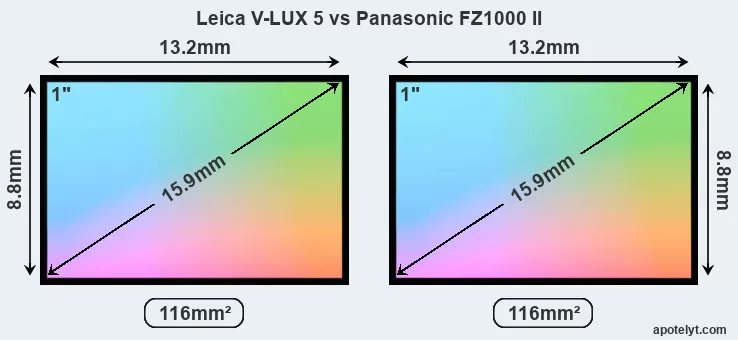
The two cameras under review do not only share the same sensor size, but also offer an identical resolution of 20 megapixels. This similarity in sensor specs implies that both the V-LUX 5 and the FZ1000 II have the same pixel density, as well as the same pixel size. It should, however, be noted that the V-LUX 5 is a somewhat more recent model (by 4 months) than the FZ1000 II, and its sensor might have benefitted from technological advances during this time.
The Leica V-LUX 5 has a native sensitivity range from ISO 125 to ISO 12800, which can be extended to ISO 80-25600. The Panasonic Lumix DC-FZ1000 II offers exactly the same ISO settings.
Technology-wise, both cameras are equipped with BSI-CMOS (Backside Illuminated Complementary Metal–Oxide–Semiconductor) sensors. Both cameras use a Bayer filter for capturing RGB colors on a square grid of photosensors. This arrangement is found in most digital cameras.
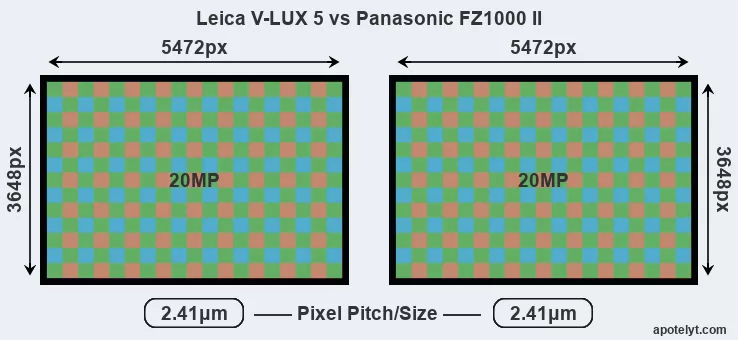
Consistent information on actual sensor performance is available from DXO Mark for many cameras. This service determines an overall sensor rating, as well as sub-scores for low-light sensitivity ("DXO Sports"), dynamic range ("DXO Landscape"), and color depth ("DXO Portrait"). The adjacent table reports on the physical sensor characteristics and the outcomes of the DXO sensor quality tests for a sample of comparator-cameras.

| # | Camera Model |
Sensor Class |
Resolution (MP) |
Horiz. Pixels |
Vert. Pixels |
Video Format |
DXO Portrait |
DXO Landscape |
DXO Sports |
DXO Overall |
|
|---|---|---|---|---|---|---|---|---|---|---|---|
| 1. | Leica V-LUX 5 | 1-inch | 20.0 | 5472 | 3648 | 4K/30p | 22.2 | 12.4 | 584 | 65 | |
| 2. | Panasonic FZ1000 II | 1-inch | 20.0 | 5472 | 3648 | 4K/30p | 22.1 | 12.4 | 546 | 65 | |
| 3. | Canon SX740 | 1/2.3 | 20.2 | 5184 | 3888 | 4K/30p | 20.6 | 12.1 | 1050 | 51 | |
| 4. | Leica D-LUX 7 | Four Thirds | 16.8 | 4736 | 3552 | 4K/30p | 22.9 | 12.8 | 1002 | 72 | |
| 5. | Leica C-LUX | 1-inch | 20.0 | 5472 | 3648 | 4K/30p | 22.1 | 12.3 | 481 | 64 | |
| 6. | Leica V-LUX Typ 114 | 1-inch | 20.0 | 5472 | 3648 | 4K/30p | 21.6 | 11.7 | 127 | 60 | |
| 7. | Panasonic TZ95 | 1/2.3 | 20.2 | 5184 | 3888 | 4K/30p | 20.7 | 12.2 | 1103 | 52 | |
| 8. | Panasonic LX100 II | Four Thirds | 16.8 | 4736 | 3552 | 4K/30p | 22.8 | 12.7 | 979 | 72 | |
| 9. | Panasonic TZ200 | 1-inch | 20.0 | 5472 | 3648 | 4K/30p | 22.0 | 12.2 | 449 | 64 | |
| 10. | Panasonic FZ2000 | 1-inch | 20.0 | 5472 | 3648 | 4K/30p | 23.0 | 12.6 | 538 | 70 | |
| 11. | Panasonic FZ1000 | 1-inch | 20.0 | 5472 | 3648 | 4K/30p | 22.1 | 11.7 | 517 | 64 | |
| 12. | Sony RX100 VII | 1-inch | 20.0 | 5472 | 3648 | 4K/30p | 21.8 | 12.4 | 418 | 63 | |
| 13. | Sony RX100 VI | 1-inch | 20.0 | 5472 | 3648 | 4K/30p | 22.1 | 12.3 | 478 | 64 | |
| Note: DXO values in italics represent estimates based on sensor size and age. | |||||||||||
Many modern cameras cannot only take still pictures, but also record videos. The two cameras under consideration both have sensors whose read-out speed is fast enough to capture moving pictures, and both provide the same movie specifications (4K/30p).
Feature comparison
Apart from body and sensor, cameras can and do differ across a variety of features. The V-LUX 5 and the FZ1000 II are similar in the sense that both feature an electronic viewfinder, which is helpful when framing images in bright sunlight. Moreover, their viewfinders offer an identical resolution of 2360k dots. The adjacent table lists some of the other core features of the Leica V-LUX 5 and Panasonic FZ1000 II along with similar information for a selection of comparators.

| # | Camera Model |
Viewfinder (Type or 000 dots) |
Control Panel (yes/no) |
LCD Specifications (inch/000 dots) |
LCD Attach- ment |
Touch Screen (yes/no) |
Max Shutter Speed * |
Max Shutter Flaps * |
Built-in Flash (yes/no) |
Built-in Image Stab |
|
|---|---|---|---|---|---|---|---|---|---|---|---|
| 1. | Leica V-LUX 5 | 2360 | n | 3.0 / 1240 | swivel | Y | 1/4000s | 12.0/s | Y | Y | |
| 2. | Panasonic FZ1000 II | 2360 | n | 3.0 / 1240 | swivel | Y | 1/4000s | 12.0/s | Y | Y | |
| 3. | Canon SX740 | none | n | 3.0 / 922 | tilting | n | 1/3200s | 10.0/s | Y | Y | |
| 4. | Leica D-LUX 7 | 2764 | n | 3.0 / 1240 | fixed | Y | 1/4000s | 11.0/s | n | Y | |
| 5. | Leica C-LUX | 2330 | n | 3.0 / 1240 | fixed | Y | 1/2000s | 10.0/s | Y | Y | |
| 6. | Leica V-LUX Typ 114 | 2359 | n | 3.0 / 921 | swivel | n | 1/4000s | 12.0/s | Y | Y | |
| 7. | Panasonic TZ95 | 2330 | n | 3.0 / 1040 | tilting | Y | 1/2000s | 10.0/s | Y | Y | |
| 8. | Panasonic LX100 II | 2764 | n | 3.0 / 1240 | fixed | Y | 1/4000s | 11.0/s | n | Y | |
| 9. | Panasonic TZ200 | 2330 | n | 3.0 / 1240 | fixed | Y | 1/2000s | 10.0/s | Y | Y | |
| 10. | Panasonic FZ2000 | 2360 | n | 3.0 / 1040 | swivel | Y | 1/4000s | 12.0/s | Y | Y | |
| 11. | Panasonic FZ1000 | 2359 | n | 3.0 / 921 | swivel | n | 1/4000s | 12.0/s | Y | Y | |
| 12. | Sony RX100 VII | 2359 | n | 3.0 / 921 | tilting | Y | 1/2000s | 90.0/s | Y | Y | |
| 13. | Sony RX100 VI | 2359 | n | 3.0 / 1229 | tilting | Y | 1/2000s | 24.0/s | Y | Y | |
| Note: *) Information refers to the mechanical shutter, unless the camera only has an electronic one. | |||||||||||
The reported shutter speed information refers to the use of the mechanical shutter. Yet, some cameras only have an electronic shutter, while others have an electronic shutter in addition to a mechanical one. In fact, both cameras under consideration feature an electronic shutter, which makes completely silent shooting possible. However, this mode is less suitable for photographing moving objects (risk of rolling shutter) or shooting under artificial light sources (risk of flickering).
The Leica V-LUX 5 and the Panasonic FZ1000 II both have an intervalometer built-in. This enables the photographer to capture time lapse sequences, such as flower blooming, a sunset or moon rise, without purchasing an external camera trigger and related software.
Both the V-LUX 5 and the FZ1000 II have zoom lenses built in. Both optics have identical focal length range and aperture specifications (9.1-146mm f/2.8-4.0). Both cameras offer the same maximum aperture.
Concerning the storage of imaging data, both the V-LUX 5 and the FZ1000 II write their files to SDXC cards. Both cameras can use UHS-I cards, which provide for Ultra High Speed data transfer of up to 104 MB/s.
Connectivity comparison
For some imaging applications, the extent to which a camera can communicate with its environment can be an important aspect in the camera decision process. The table below provides an overview of the connectivity of the Leica V-LUX 5 and Panasonic Lumix DC-FZ1000 II and, in particular, the interfaces the cameras (and selected comparators) provide for accessory control and data transfer.

| # | Camera Model |
Hotshoe Port |
Internal Mic / Speaker |
Microphone Port |
Headphone Port |
HDMI Port |
USB Port |
WiFi Support |
NFC Support |
Bluetooth Support |
|
|---|---|---|---|---|---|---|---|---|---|---|---|
| 1. | Leica V-LUX 5 | Y | stereo / mono | - | - | micro | 2.0 | Y | - | Y | |
| 2. | Panasonic FZ1000 II | Y | stereo / mono | Y | - | micro | 2.0 | Y | - | Y | |
| 3. | Canon SX740 | - | stereo / mono | - | - | micro | 2.0 | Y | - | Y | |
| 4. | Leica D-LUX 7 | Y | stereo / mono | - | - | micro | 2.0 | Y | - | Y | |
| 5. | Leica C-LUX | - | stereo / mono | - | - | micro | 2.0 | Y | - | - | |
| 6. | Leica V-LUX Typ 114 | Y | stereo / mono | Y | - | micro | 2.0 | Y | Y | - | |
| 7. | Panasonic TZ95 | - | stereo / mono | - | - | micro | 2.0 | Y | - | Y | |
| 8. | Panasonic LX100 II | Y | stereo / mono | - | - | micro | 2.0 | Y | - | Y | |
| 9. | Panasonic TZ200 | - | stereo / mono | - | - | micro | 2.0 | Y | - | Y | |
| 10. | Panasonic FZ2000 | Y | stereo / mono | Y | Y | micro | 2.0 | Y | - | - | |
| 11. | Panasonic FZ1000 | Y | stereo / mono | Y | - | micro | 2.0 | Y | Y | - | |
| 12. | Sony RX100 VII | - | stereo / mono | Y | - | micro | 2.0 | Y | Y | Y | |
| 13. | Sony RX100 VI | - | stereo / mono | - | - | micro | 2.0 | Y | Y | Y |
It is notable that the FZ1000 II has a microphone port, which can help to improve the quality of audio recordings by attaching an external microphone. The V-LUX 5 does not feature such a mic input.
Both the V-LUX 5 and the FZ1000 II are recent models that are part of the current product line-up. The FZ1000 II replaced the earlier Panasonic FZ1000, while the V-LUX 5 followed on from the Leica V-LUX Typ 114. Further information on the features and operation of the V-LUX 5 and FZ1000 II can be found, respectively, in the Leica V-LUX 5 Manual (free pdf) or the online Panasonic FZ1000 II Manual.
Review summary
So how do things add up? Which of the two cameras – the Leica V-LUX 5 or the Panasonic FZ1000 II – has the upper hand? Is one clearly better than the other? A synthesis of the relative strong points of each of the models is listed below.

Arguments in favor of the Leica V-LUX 5:
- More prestigious: Has the Leica luxury appeal, which ensures a high resale price.
- More modern: Is somewhat more recent (announced 4 months after the FZ1000 II).

Advantages of the Panasonic Lumix DC-FZ1000 II:
- Better sound: Can connect to an external microphone for higher quality sound recording.
- More affordable: Was introduced into a lower priced category (28 percent cheaper at launch).
- More heavily discounted: Has been on the market for longer (launched in February 2019).
If the count of individual advantages (bullet points above) is taken as a guide, the FZ1000 II comes out slightly ahead of the V-LUX 5 (3 : 2 points). However, the relative importance of the various individual camera aspects will vary according to personal preferences and needs, so that you might like to apply corresponding weights to the particular features before making a decision on a new camera. A professional wedding photographer will view the differences between cameras in a way that diverges from the perspective of a travel photog, and a person interested in cityscapes has distinct needs from a macro shooter. Hence, the decision which camera is best and worth buying is often a very personal one.
How about other alternatives? Do the specifications of the Leica V-LUX 5 and the Panasonic FZ1000 II place the cameras among the top in their class? Find out in the latest Best Superzoom Camera listing whether the two cameras rank among the cream of the crop.
In any case, while the comparison of the spec-sheets of cameras can offer a general idea of their imaging potential, it says little about, for example, the shooting experience and imaging performance of the V-LUX 5 and the FZ1000 II in practical situations. User reviews, such as those found at amazon, can sometimes inform about these issues, but such feedback is often incomplete, inconsistent, and biased.
Expert reviews
This is why expert reviews are important. The table below provides a synthesis of the camera assessments of some of the best known photo-gear review sites (amateurphotographer [AP], cameralabs [CL], digitalcameraworld [DCW], dpreview [DPR], ephotozine [EPZ], photographyblog [PB]). As can be seen, the professional reviewers agree in many cases on the quality of different cameras, but sometimes their assessments diverge, reinforcing the earlier point that a camera decision is often a very personal choice.

| # | Camera Model |
AP score |
CL score |
DCW score |
DPR score |
EPZ score |
PB score |
Camera Launch |
Launch Price (USD) |
Street Price |
|
|---|---|---|---|---|---|---|---|---|---|---|---|
| 1. | Leica V-LUX 5 | .. | .. | .. | .. | 4/5 | 4/5 | Jul 2019 | 1,249 | amazon.com | |
| 2. | Panasonic FZ1000 II | .. | .. | .. | 83/100 | 4.5/5 | 4.5/5 | Feb 2019 | 899 | amazon.com | |
| 3. | Canon SX740 | .. | + | 3.5/5 | .. | 4/5 | 4/5 | Jul 2018 | 399 | amazon.com | |
| 4. | Leica D-LUX 7 | .. | .. | .. | .. | .. | 4.5/5 | Nov 2018 | 1,195 | ebay.com | |
| 5. | Leica C-LUX | .. | .. | 3.5/5 | .. | 4.5/5 | 4/5 | Jun 2018 | 1,049 | ebay.com | |
| 6. | Leica V-LUX Typ 114 | .. | .. | .. | .. | .. | 5/5 | Sep 2014 | 1,349 | ebay.com | |
| 7. | Panasonic TZ95 | .. | + + | .. | .. | 4.5/5 | .. | Feb 2019 | 449 | ebay.com | |
| 8. | Panasonic LX100 II | 4.5/5 | + | 4.2/5 | 82/100 | 4.5/5 | 4.5/5 | Aug 2018 | 999 | ebay.com | |
| 9. | Panasonic TZ200 | .. | + + | 4.5/5 | 81/100 | 4.5/5 | 4.5/5 | Feb 2018 | 799 | amazon.com | |
| 10. | Panasonic FZ2000 | .. | + | .. | 82/100 | 4.5/5 | 5/5 | Sep 2016 | 1,199 | amazon.com | |
| 11. | Panasonic FZ1000 | 4/5 | + + | .. | 82/100 | 4.5/5 | 4.5/5 | Jun 2014 | 899 | ebay.com | |
| 12. | Sony RX100 VII | 4.5/5 | .. | 4/5 | .. | 4/5 | 5/5 | Jul 2019 | 1,199 | amazon.com | |
| 13. | Sony RX100 VI | 4.5/5 | + + | .. | 83/100 | 4/5 | 4.5/5 | Jun 2018 | 1,199 | ebay.com | |
| Note: (+ +) highly recommended; (+) recommended; (o) reviewed; (..) not available. | |||||||||||
The above review scores should be interpreted with care, though. The ratings are only valid when referring to cameras in the same category and of the same age. A score, therefore, has to be seen in close connection to the price and market introduction time of the camera, and comparisons of ratings among very different cameras or across long time periods have little meaning. It should also be noted that some of the review sites have over time altered the way they render their verdicts.

Check V-LUX 5 price at
amazon.com

Check FZ1000 II price at
amazon.com
Other camera comparisons
Did this review help to inform your camera decision process? In case you are interested in seeing how other cameras pair up, just make your choice using the following search menu. As an alternative, you can also directly jump to any one of the listed comparisons that were previously generated by the CAM-parator tool.
- Canon 5D Mark IV vs Leica V-LUX 5
- Canon SL3 vs Leica V-LUX 5
- Fujifilm X-Pro1 vs Leica V-LUX 5
- Fujifilm X-Pro1 vs Panasonic FZ1000 II
- Fujifilm XP130 vs Panasonic FZ1000 II
- Leica V-LUX 5 vs Olympus E-PL8
- Leica V-LUX 5 vs Panasonic FZ300
- Leica V-LUX 5 vs Panasonic GX80
- Nikon D2H vs Panasonic FZ1000 II
- Nikon D60 vs Panasonic FZ1000 II
- Olympus E-P1 vs Panasonic FZ1000 II
- Panasonic FZ1000 II vs Sony ZV-E10
Specifications: Leica V-LUX 5 vs Panasonic FZ1000 II
Below is a side-by-side comparison of the specs of the two cameras to facilitate a quick review of their differences and common features.
| Camera Model | Leica V-LUX 5 | Panasonic FZ1000 II |
|---|---|---|
| Camera Type | Fixed lens compact camera | Fixed lens compact camera |
| Camera Lens | 25-400mm f/2.8-4.0 | 25-400mm f/2.8-4.0 |
| Launch Date | July 2019 | February 2019 |
| Launch Price | USD 1,249 | USD 899 |
| Sensor Specs | Leica V-LUX 5 | Panasonic FZ1000 II |
| Sensor Technology | BSI-CMOS | BSI-CMOS |
| Sensor Format | 1" Sensor | 1" Sensor |
| Sensor Size | 13.2 x 8.8 mm | 13.2 x 8.8 mm |
| Sensor Area | 116.16 mm2 | 116.16 mm2 |
| Sensor Diagonal | 15.9 mm | 15.9 mm |
| Crop Factor | 2.7x | 2.7x |
| Sensor Resolution | 20 Megapixels | 20 Megapixels |
| Image Resolution | 5472 x 3648 pixels | 5472 x 3648 pixels |
| Pixel Pitch | 2.41 μm | 2.41 μm |
| Pixel Density | 17.18 MP/cm2 | 17.18 MP/cm2 |
| Moiré control | Anti-Alias filter | Anti-Alias filter |
| Movie Capability | 4K/30p Video | 4K/30p Video |
| ISO Setting | 125 - 12,800 ISO | 125 - 12,800 ISO |
| ISO Boost | 80 - 25,600 ISO | 80 - 25,600 ISO |
| Screen Specs | Leica V-LUX 5 | Panasonic FZ1000 II |
| Viewfinder Type | Electronic viewfinder | Electronic viewfinder |
| Viewfinder Field of View | 100% | 100% |
| Viewfinder Magnification | 0.70x | 0.70x |
| Viewfinder Resolution | 2360k dots | 2360k dots |
| LCD Framing | Live View | Live View |
| Rear LCD Size | 3.0inch | 3.0inch |
| LCD Resolution | 1240k dots | 1240k dots |
| LCD Attachment | Swivel screen | Swivel screen |
| Touch Input | Touchscreen | Touchscreen |
| Shooting Specs | Leica V-LUX 5 | Panasonic FZ1000 II |
| Focus System | Contrast-detect AF | Contrast-detect AF |
| Manual Focusing Aid | Focus Peaking | Focus Peaking |
| Max Shutter Speed (mechanical) | 1/4000s | 1/4000s |
| Continuous Shooting | 12 shutter flaps/s | 12 shutter flaps/s |
| Electronic Shutter | up to 1/16000s | up to 1/16000s |
| Time-Lapse Photography | Intervalometer built-in | Intervalometer built-in |
| Fill Flash | Built-in Flash | Built-in Flash |
| Storage Medium | SDXC cards | SDXC cards |
| Single or Dual Card Slots | Single card slot | Single card slot |
| UHS card support | UHS-I | UHS-I |
| Connectivity Specs | Leica V-LUX 5 | Panasonic FZ1000 II |
| External Flash | Hotshoe | Hotshoe |
| USB Connector | USB 2.0 | USB 2.0 |
| HDMI Port | micro HDMI | micro HDMI |
| Microphone Port | no MIC socket | External MIC port |
| Wifi Support | Wifi built-in | Wifi built-in |
| Bluetooth Support | Bluetooth built-in | Bluetooth built-in |
| Body Specs | Leica V-LUX 5 | Panasonic FZ1000 II |
| Battery Type | Leica BP-DC12 | Panasonic DMW-BLC12 |
| Battery Life (CIPA) | 350 shots per charge | 350 shots per charge |
| In-Camera Charging | USB charging | USB charging |
| Body Dimensions |
136 x 97 x 131 mm (5.4 x 3.8 x 5.2 in) |
136 x 97 x 131 mm (5.4 x 3.8 x 5.2 in) |
| Camera Weight | 812 g (28.6 oz) | 810 g (28.6 oz) |

Check V-LUX 5 price at
amazon.com

Check FZ1000 II price at
amazon.com
Did you notice an error on this page? If so, please get in touch, so that we can correct the information.

